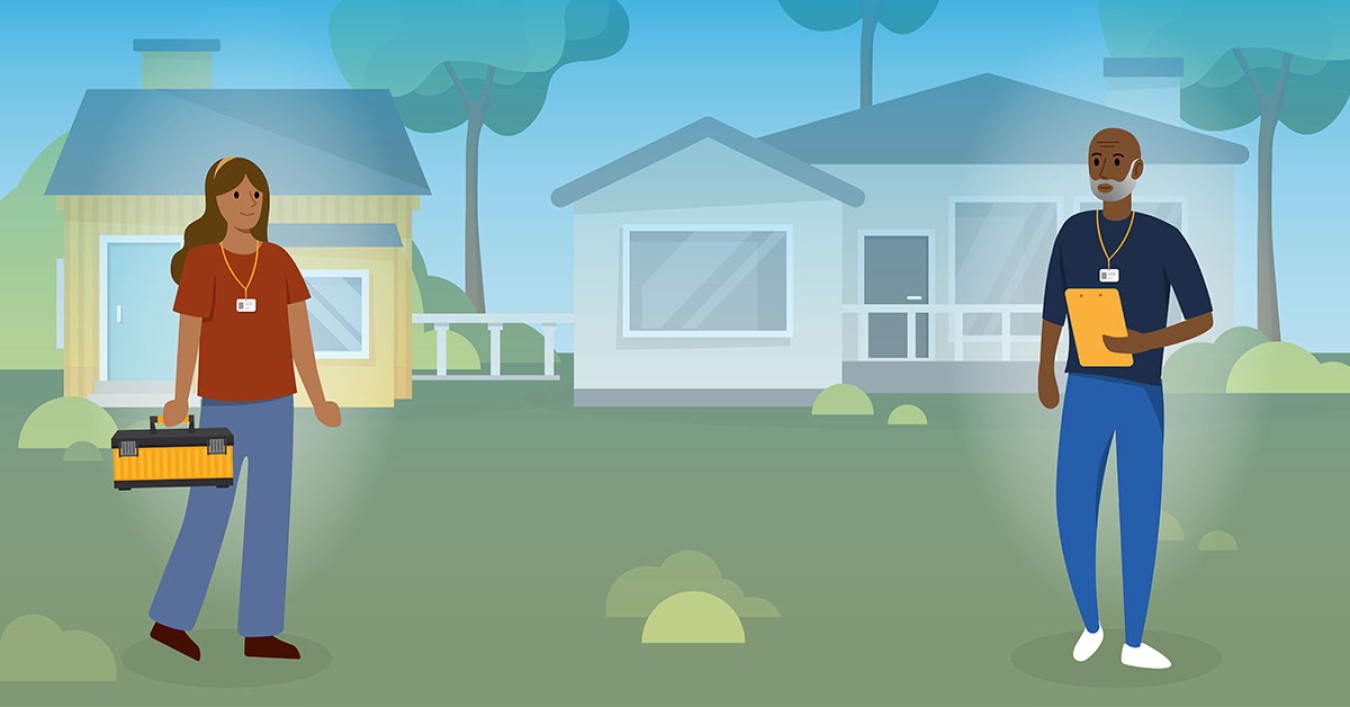Since 2015, Minnesota has received $98.4 million from the Weatherization Assistance Program (WAP) and $9.9 million from the State Energy Program (SEP), resulting in the following benefits:

8,554 Homes Weatherized
Minnesota reduced energy costs and improved health and safety in 8,554 homes.*

792 Jobs Created or Retained
The State Energy Program creates or retains one job for every $12,500 invested.*

5.8 Million Square Feet of Building Space Retrofitted
Since 2015, Minnesota has installed energy efficiency upgrades in 105 buildings.*

Connected with 245,708 People About Energy Efficiency Installations
Minnesota held 333 workshops, webinars, trainings, or outreach events since 2015.*
* Findings from a National Evaluation of the State Energy Program and a National Evaluation of the Weatherization Assistance Program.
States report outcomes of State Energy Program and Weatherization Assistance Program formula (annual) fund activities to DOE on a quarterly basis. The metrics above are outcomes of formula-funded activities since 2015.
The SCEP Project Map highlights the annual formula and competitive funding for WAP and SEP.
Minnesota's State Energy Program at Work
Guaranteed Energy Savings Program
Minnesota created a Guaranteed Energy Savings Program (GESP) to deliver technical, financial, and contractual assistance to state agencies, local governments, school districts, colleges, and universities to support the implementation of energy savings performance contracts.
Eleven projects totaling approximately $58 million are under contract. These projects are projected to save $3.2 million and 108 billion British thermal units (Btu) of energy annually (or 108 billion Btus of energy annually).
Implementation of Electric Utility Infrastructure Efficiency
Minnesota and partners identified supply-side efficiency opportunities and barriers in the electric generation, transmission, and distribution system that have significant potential for energy savings and emission reductions.
Minnesota addressed the regulatory uncertainty that existed around how electric utility infrastructure (EUI) efficiency improvements, such as high-efficiency transformers and conservation voltage reduction, fit into Minnesota's policy and regulatory framework, helping stakeholders leverage tools shown to be successful on the demand-side to also improve the overall generation, transmission, and distribution efficiency of the electric system.
Energy Efficiency Implementation in Wastewater Treatment Facilities
Minnesota and partners set goals to decrease energy use in state municipal wastewater treatment facilities and scope opportunities for energy generation at suitable facilities. Over the course of the project, Minnesota carried out in-depth facility assessments which identified energy and cost-saving opportunities, supported facilities to execute implementation plans, measured and tracked results, and increased outreach by engaging facilities ready to invest in energy efficiency projects. This included in-depth facility assessments for distributed energy generation.
As of 2023, Minnesota has implemented energy efficiency improvements in 20 wastewater facilities, resulting in approximately 5.5 million kilowatt-hours (kWh) in annual energy savings, with more than 2 million kWh of annual energy savings planned to be implemented through the next cohort program conducted in partnership with the university of Minnesota Technical Assistance Program (MNTAP).
Learn more about the Wastewater Treatment Plant Project: Energy Efficiency & Renewable Energy Generation.
Minnesota 2025 Energy Action Plan
Funded through a U.S. Department of Energy (DOE) grant, the 2025 Energy Action Plan centers on consensus-driven, near-term strategies that add value to Minnesota's dynamic energy landscape.
Minnesota worked with a multidisciplinary group of over 50 stakeholders to collect input on energy technologies and build on existing efforts. Together, the project team established a framework with action-oriented strategies and timelines to protect the environment and create jobs.
Minnesota’s baseline energy landscape metrics, presentations, and final report are available at the 2025 Energy Action Plan website.
Learn more about SEP competitively awarded projects.
Minnesota's Weatherization Assistance Program at Work
The Minnesota Department of Commerce is the managing agency for Minnesota's Weatherization Assistance Program. The Minnesota WAP Commerce contracts with local community action agencies and nonprofits to install weatherization improvements in low-income households throughout the state.
Between 2010 and 2021, Minnesota weatherized an average of 978 homes per year with formula funds.
Success Stories
Read other SCEP News and Success Stories.
Minnesota Takes Initiative
Better Buildings Initiative
More than 900 organizations are involved in the Better Buildings Initiative working to reduce energy and water waste and modernize the nation’s buildings and industrial facilities. Download the 2023 Better Buildings Progress Report for more information on the Initiative as a whole.
Better Buildings Challenge Partners
The state of Minnesota has taken on the Better Buildings Challenge, a commitment to reduce the energy use of their entire building portfolios by 20% within 10 years and are making progress toward their energy reduction goals. As of 2021, public-sector Challenge partners have cumulatively saved 133 trillion Btus of energy, $1.27 billion, and 1.5 billion gallons of water since the Challenge was launched in 2011.
Better Climate Challenge
The U.S. Department of Energy (DOE) is challenging organizations to set ambitious, portfolio-wide GHG emission reduction goals. This new effort provides additional opportunities for peer exchange and technical assistance to meet the urgent call to mitigate the impacts of climate change.
The city of Saint Paul has joined the Better Climate Challenge, a commitment to reduce their portfolio-wide scope 1 and 2 GHG emissions by at least 50% within 10 years. Saint Paul will pursue an energy efficiency target as part of this commitment, recognizing efficiency as a key driver of decarbonization.
Better Buildings Accelerators
In the past five years, SCEP has engaged nearly 100 partners in Better Buildings Accelerators. These Accelerators are designed to demonstrate specific innovative policies and approaches, which will accelerate investment in energy efficiency upon successful demonstration. Each Accelerator is a targeted, short-term, partner-focused activity designed to address persistent barriers that stand in the way of greater efficiency.
To learn more about other Better Buildings partners and solutions in the state of California and other states involved in the Better Buildings Initiative, check out the Better Buildings Partner map.
ESPC Accelerator Partners
The state of Minnesota helped catalyze public-sector energy efficiency investments of over $2.1 billion in Energy Savings Performance Contracting (ESPC) from 2014–2016 as one of 25 state and local agency partners in the ESPC Accelerator. See demonstrated best practices in the ESPC Toolkit.
Sustainable Wastewater of the Future (SWIFt) Initiative
The state of Minnesota committed to improving the energy efficiency of their participating water resource recovery facilities as part of the Sustainable Wastewater Infrastructure of the Future (SWIFt) Initiative Phase 1 from 2016-2019. SWIFt Phase 1 hosted 25 state, regional, and local agencies that engaged with more than 70 water resource recovery facilities in their jurisdictions and successfully reduced their total energy consumption by almost 7%, adopted best-practice energy management approaches showcased in the Wastewater Energy Management Toolkit, and created plans to achieve 30% energy savings.
Additionally, the state of Minnesota and the city of Big Lake have gone on to join SWIFt Phase 2. SWIFt Phase 2 is engaging wastewater treatment facilities in a voluntarily partnership to achieve 5% short-term and 25% long-term facility-wide energy savings and implement at least one next-generation technology (e.g., renewable energy, resource recovery, and advanced data management).
Sustainable Corrections Infrastructure Partnership (SCIP) Accelerator
The state of Minnesota is a participant in the Sustainable Corrections Infrastructure Partnership (SCIP) Accelerator, a voluntary partnership of state and local public correctional facilities working with DOE over three years (2021-2024) to achieve portfolio-wide energy and water savings of 20%, implement energy management systems, and create replicable solutions to catalyze energy resilience in the corrections sector. As of November 2021, SCIP had 17 partners consisting of 16 states and 1 county that represent almost 30% of state correctional facilities in the U.S.
Publications, Resources, Helpful Links
- State and Local Solution Center, a one-stop shop of impactful public-sector resources
- Weatherization Assistance Program
- State Energy Program
- NASEO State Energy Office Contact
- Contact Weatherization Agency
- EIA Minnesota State Profile and Energy Estimates
- Minnesota Better Buildings Challenge Partner Profile
